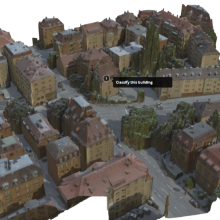The overall goal of the Collaborative Research Center is establishing the paradigm of quantitative science in visual computing. In several directions it will provide conceptual and tangible contributions, including conceptual metrics and models for quantification, new techniques and algorithms for visual computing, respective software, benchmark data that can be used for quantitative evaluation, and improved evaluation methodology.
Our work package Perception-Guided Adaptive Modeling of 3D Virtual Cities aims at creating quantitative methods for the perception-aware representation of 3D virtual cities. We want to create a model for the effective visual communication of urban- or building-related semantic information via geometric 3D building representations which induce a maximum degree of perceptual insight in the user’s mind. To create such a model/framework we need to perform user studies to get a deeper understanding of a human’s cognitive experience of virtual 3D cities.
A first application of knowledge derived from a user study is perception-based abstraction, which ensures to maintain those geometric properties that are important for a user to associate a building to its correct category.

Volker Walter
Dr.-Ing.Head of Research Group Geoinformatics





